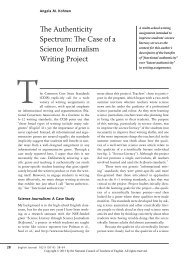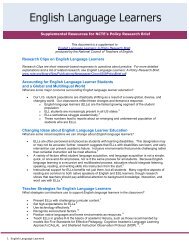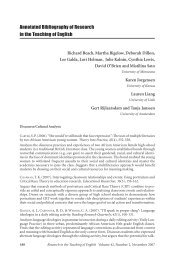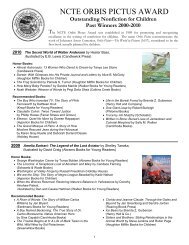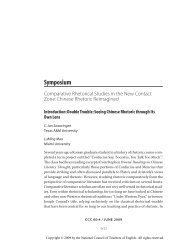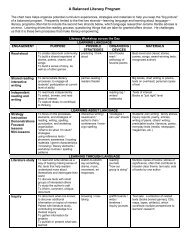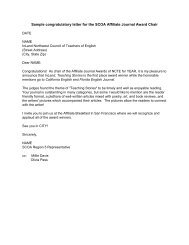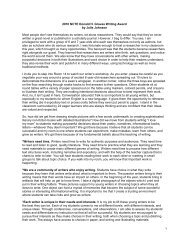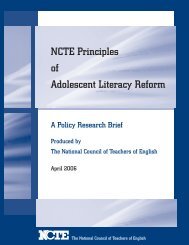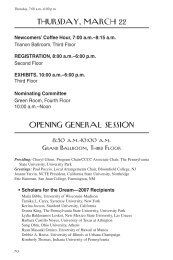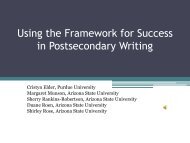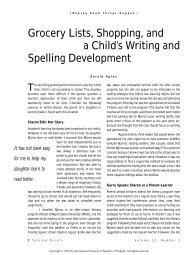Annotated Bibliography of Research in the Teaching of English
Annotated Bibliography of Research in the Teaching of English
Annotated Bibliography of Research in the Teaching of English
- No tags were found...
Create successful ePaper yourself
Turn your PDF publications into a flip-book with our unique Google optimized e-Paper software.
226 <strong>Research</strong> <strong>in</strong> <strong>the</strong> Teach<strong>in</strong>g <strong>of</strong> <strong>English</strong> Volume 41 November 2006tural and language difference, exam<strong>in</strong>ation <strong>of</strong> issues <strong>of</strong> equity, and model<strong>in</strong>g <strong>of</strong> culturally responsivepedagogy <strong>in</strong> <strong>the</strong>ir methods courses. For <strong>the</strong>ir practicum and student teach<strong>in</strong>g experience,teachers benefited from ongo<strong>in</strong>g support and scaffold<strong>in</strong>g <strong>of</strong> a focus on <strong>the</strong>se aspects <strong>of</strong><strong>the</strong>ir program by supervisors, cooperat<strong>in</strong>g teachers, and cohort <strong>in</strong>teractions.BICKMORE, S. T., SMAGORINSKY, P., & O’DONNELL-ALLEN, C. (2005). Tensions between traditions:The role <strong>of</strong> contexts <strong>in</strong> learn<strong>in</strong>g to teach. <strong>English</strong> Education, 38(1), 23-52.Analyzes <strong>the</strong> teacher education experience <strong>of</strong> one teacher mov<strong>in</strong>g through <strong>the</strong> contexts <strong>of</strong> hisuniversity program, student teach<strong>in</strong>g site, and first job—<strong>in</strong> learn<strong>in</strong>g how to teach. F<strong>in</strong>ds that heconfronts tensions with<strong>in</strong> his program and between his program’s beliefs about teach<strong>in</strong>g andthose operat<strong>in</strong>g <strong>in</strong> <strong>the</strong> schools. Suggests <strong>the</strong> need for teacher education programs to providegreater conceptual unity, and that when such programs do not provide conceptual unity, evenstrong student teachers can emerge without essential critical tools to <strong>in</strong>form and motivate <strong>the</strong>irteach<strong>in</strong>g.KATZ, S., SUTHERLAND, S., & EARL, L. (2005). Toward an evaluation habit <strong>of</strong> m<strong>in</strong>d: Mapp<strong>in</strong>g <strong>the</strong>journey. Teachers College Record, 107(10), 2326-2350.Analyzes issues associated with implementation <strong>of</strong> The Manitoba School Improvement Programon teachers’, adm<strong>in</strong>istrators’, and educational consultants’ attempts to evaluate studentwork. F<strong>in</strong>ds that a focus on evaluation and evidence-based decision-mak<strong>in</strong>g can be transformedfrom a reaction to external mandates to a central orientation focused on assess<strong>in</strong>g <strong>the</strong> fundamentalaims <strong>of</strong> school<strong>in</strong>g. F<strong>in</strong>ds that <strong>the</strong> quality <strong>of</strong> <strong>the</strong> curriculum <strong>of</strong> pr<strong>of</strong>essional developmentplays an important role <strong>in</strong> <strong>the</strong> effectiveness <strong>of</strong> <strong>the</strong> program.LEWIS, C., PERRY, R., & MURATA, A. (2006). How should research contribute to <strong>in</strong>structional improvement?The case <strong>of</strong> lesson study. Educational <strong>Research</strong>er, 35(3), 3-14.Exam<strong>in</strong>es issues <strong>of</strong> transplant<strong>in</strong>g <strong>the</strong> culturally and <strong>in</strong>stitutionally grounded Japanese practice<strong>of</strong> lesson study <strong>in</strong>to American contexts. Identifies three critical needs: expand<strong>in</strong>g <strong>the</strong> knowledgebase about lesson study <strong>in</strong> Japan and <strong>the</strong> US, explicat<strong>in</strong>g how lesson study serves as a mechanismfor <strong>in</strong>novation, and foster<strong>in</strong>g design-based research cycles. Suggests <strong>the</strong> need to considerref<strong>in</strong><strong>in</strong>g <strong>the</strong> use <strong>of</strong> lesson study with<strong>in</strong> this country.ROGERS, T., MARSHALL, E., & TYSON, C. A. (2006). Dialogic narratives <strong>of</strong> literacy, teach<strong>in</strong>g, andschool<strong>in</strong>g: Prepar<strong>in</strong>g literacy teachers for diverse sett<strong>in</strong>gs. Read<strong>in</strong>g <strong>Research</strong> Quarterly, 41(2),202-224.Exam<strong>in</strong>es <strong>the</strong> discourses <strong>in</strong> preservice literacy teachers’ narratives <strong>in</strong> terms <strong>of</strong> <strong>the</strong> dialogic tensionsassociated with <strong>the</strong> development <strong>of</strong> <strong>the</strong>ir pr<strong>of</strong>essional identities dur<strong>in</strong>g <strong>the</strong>ir teacher educationprogram and experiences <strong>in</strong> community-based <strong>in</strong>ternships. F<strong>in</strong>ds tensions between authoritativeand <strong>in</strong>ternally persuasive discourses associated with operat<strong>in</strong>g <strong>in</strong> culturally diversesett<strong>in</strong>gs, particularly <strong>in</strong> terms <strong>of</strong> challeng<strong>in</strong>g <strong>the</strong>ir discourses <strong>of</strong> diversity and social justice. Suggests<strong>the</strong> value <strong>of</strong> immers<strong>in</strong>g preservice teachers <strong>in</strong> and foster<strong>in</strong>g reflections about diverse community-basedexperiences.O<strong>the</strong>r Related <strong>Research</strong>:AGEE, J. (2006). What k<strong>in</strong>d <strong>of</strong> teacher will I be? Creat<strong>in</strong>g spaces for beg<strong>in</strong>n<strong>in</strong>g teachers’ imag<strong>in</strong>edroles. <strong>English</strong> Education, 38(3), 194-219.ASSAF, L. (2005). Explor<strong>in</strong>g identities <strong>in</strong> a read<strong>in</strong>g specialization program. Journal <strong>of</strong> Literacy<strong>Research</strong>, 37(2), 201-236.BROCK, C., WALLACE, J., & HERSCHBACH, M. (2006). Negotiat<strong>in</strong>g displacement spaces: Explor<strong>in</strong>gteachers’ stories about learn<strong>in</strong>g and diversity. Curriculum Inquiry, 36(1), 35-62.CARROLL, D. (2005). Learn<strong>in</strong>g through <strong>in</strong>teractive talk: A school-based mentor-teacher studentgroup as a context for pr<strong>of</strong>essional learn<strong>in</strong>g. Teach<strong>in</strong>g and Teacher Education: An InternationalJournal <strong>of</strong> <strong>Research</strong> and Studies, 21(5), 457-473.



